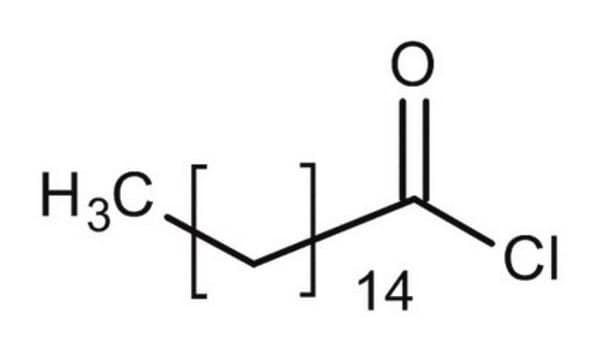156930
Lauroyl chloride
98%
Sinonimo/i:
Dodecanoyl chloride
About This Item
Prodotti consigliati
Saggio
98%
Forma fisica
liquid
Indice di rifrazione
n20/D 1.445 (lit.)
P. eboll.
134-137 °C/11 mmHg (lit.)
Solubilità
methanol: soluble 100 mg/mL, clear
Densità
0.946 g/mL at 25 °C (lit.)
Stringa SMILE
CCCCCCCCCCCC(Cl)=O
InChI
1S/C12H23ClO/c1-2-3-4-5-6-7-8-9-10-11-12(13)14/h2-11H2,1H3
NQGIJDNPUZEBRU-UHFFFAOYSA-N
Applicazioni
- as tailoring agent for chemical modification of nanocelluloses of different length, nanofibrillated cellulose and cellulose nanocrystals
- in the preparation of acylated collagen with water solubility and better surface activity
- as organic low-friction boundary lubricant in the preparation of novel polyvinyl alcohol hydrogel
- in the synthesis of hemicellulose-based hydrophobic biomaterials
Avvertenze
Danger
Indicazioni di pericolo
Classi di pericolo
Skin Corr. 1B
Codice della classe di stoccaggio
8A - Combustible corrosive hazardous materials
Classe di pericolosità dell'acqua (WGK)
WGK 3
Punto d’infiammabilità (°F)
284.0 °F - closed cup
Punto d’infiammabilità (°C)
140 °C - closed cup
Dispositivi di protezione individuale
Faceshields, Gloves, Goggles, type ABEK (EN14387) respirator filter
Certificati d'analisi (COA)
Cerca il Certificati d'analisi (COA) digitando il numero di lotto/batch corrispondente. I numeri di lotto o di batch sono stampati sull'etichetta dei prodotti dopo la parola ‘Lotto’ o ‘Batch’.
Possiedi già questo prodotto?
I documenti relativi ai prodotti acquistati recentemente sono disponibili nell’Archivio dei documenti.
I clienti hanno visto anche
Il team dei nostri ricercatori vanta grande esperienza in tutte le aree della ricerca quali Life Science, scienza dei materiali, sintesi chimica, cromatografia, discipline analitiche, ecc..
Contatta l'Assistenza Tecnica.











